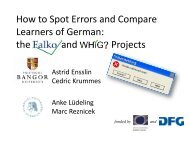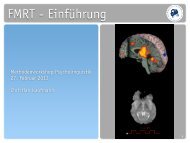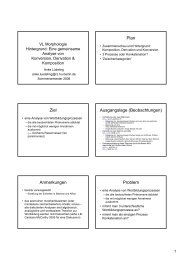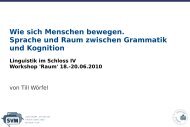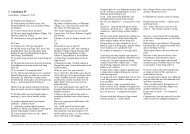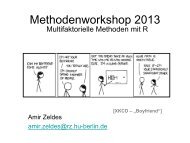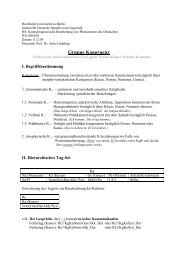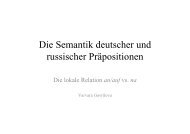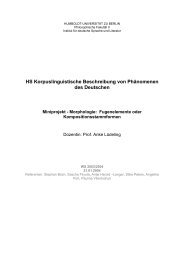Are native English words different from neoclassical English words ...
Are native English words different from neoclassical English words ...
Are native English words different from neoclassical English words ...
You also want an ePaper? Increase the reach of your titles
YUMPU automatically turns print PDFs into web optimized ePapers that Google loves.
<strong>Are</strong> <strong>native</strong> <strong>English</strong> <strong>words</strong> <strong>different</strong><br />
<strong>from</strong> <strong>neoclassical</strong> <strong>English</strong> <strong>words</strong><br />
for German speakers?<br />
Benjamin Weiss<br />
GK: Morphologie Anke Lüdeling & Penka Stateva 07.02.03 – p.1/21
Structure:<br />
• Introduction<br />
• Neoclassical word formation<br />
• Neoclassical loan-<strong>words</strong><br />
• Xenophones<br />
• An Experiment<br />
• Material<br />
• Procedure<br />
• Results<br />
• References<br />
GK: Morphologie Anke Lüdeling & Penka Stateva 07.02.03 – p.2/21
1 Introduction<br />
• Language Systems influence each other on<br />
several linguistic levels.<br />
• Eg. The use of loan-<strong>words</strong> and foreign names.<br />
• These are often not assimilated, they keep at least<br />
remains of their original language properties.<br />
• Foreign <strong>words</strong> seem to be handled special.<br />
• It is claimed that they build up their own<br />
structure(s).<br />
GK: Morphologie Anke Lüdeling & Penka Stateva 07.02.03 – p.3/21
• But what about <strong>neoclassical</strong> <strong>words</strong>?<br />
• <strong>Are</strong> they special?<br />
• There is a discussion about these <strong>words</strong> being<br />
grammatical special.<br />
• I will provide an experimental idea to test the<br />
behavior of <strong>neoclassical</strong> <strong>words</strong> as borrowings to<br />
get further insight into this topic.<br />
GK: Morphologie Anke Lüdeling & Penka Stateva 07.02.03 – p.4/21
2 Neoclassical word formation<br />
• Neoclassical <strong>words</strong> are derived <strong>from</strong> Greek or<br />
Latin but built up after the the classic age.<br />
• They are used in daily speech and have proven<br />
productive (in German).<br />
• However, they differ <strong>from</strong> <strong>native</strong> <strong>words</strong> in several<br />
aspects.<br />
• A <strong>neoclassical</strong> compound may consist of two<br />
bound forms. (hydro, graph)<br />
• Affixes can influence stress. (Instru’ment,<br />
instrumen’tal)<br />
• There are also special inflexions used with<br />
<strong>neoclassical</strong>s. (Examen, Examina)<br />
GK: Morphologie Anke Lüdeling & Penka Stateva 07.02.03 – p.5/21
• There seems to be an agreement of <strong>neoclassical</strong><br />
<strong>words</strong> being in general <strong>different</strong> <strong>from</strong> <strong>native</strong><br />
<strong>words</strong>.<br />
• The ability to identify <strong>neoclassical</strong> <strong>words</strong> is<br />
explained by differences in phonology.<br />
• Etymological knowledge can not account for this.<br />
Origin becomes less important than the word<br />
properties itself.<br />
GK: Morphologie Anke Lüdeling & Penka Stateva 07.02.03 – p.6/21
• There are <strong>different</strong> cues that can be used to<br />
recognize a word as <strong>neoclassical</strong>.<br />
• Special graphemes (ph, th, rh: Rhetorik)<br />
• non-<strong>native</strong> sounds ([Z], [Ã]: Garage, Pendant)<br />
• phonotactics (ui, ps, [ç]V: Linguist, Psyche,<br />
Chemie)<br />
• pluralization patterns<br />
• But even a combination of these features can fail<br />
(eg. also arabic <strong>words</strong> are identified as<br />
<strong>neoclassical</strong> like Alkohol).<br />
GK: Morphologie Anke Lüdeling & Penka Stateva 07.02.03 – p.7/21
2.1 Neoclassical loan-<strong>words</strong><br />
• What about <strong>neoclassical</strong> <strong>words</strong> borrowed <strong>from</strong><br />
foreign languages?<br />
• Is the the feature of being <strong>neoclassical</strong> recognized<br />
by Germans?<br />
• This can be tested by their behavior in German:<br />
• What kind of inflexions are used?<br />
• How are the <strong>words</strong> pronounced?<br />
• How do they participate in word formation?<br />
• Is their phonological structure changed?<br />
Loan-<strong>words</strong> <strong>from</strong> <strong>English</strong> seem to be the obvious<br />
choice as they build up a great number of active<br />
borrowings today (eg. Video vs. Computer).<br />
GK: Morphologie Anke Lüdeling & Penka Stateva 07.02.03 – p.8/21
3 Xenophones<br />
• Eklund & Lindström (2001): Foreign <strong>words</strong><br />
produced by Swedish speakers.<br />
• Phonetic production of foreign <strong>words</strong> varies <strong>from</strong><br />
’Swedish’ to ’<strong>English</strong>’ pronunciation due to<br />
several factors (age & educational level being<br />
most prominent).<br />
• Eg. about half of the participants produced the<br />
name Thatcher with [T].<br />
• This sound is not part of the Swedish<br />
phoneme-system<br />
• But it is part of the phone-system of lots of<br />
speakers –> xenophone.<br />
GK: Morphologie Anke Lüdeling & Penka Stateva 07.02.03 – p.9/21
• The use of such xenophones depends on:<br />
• the foreign language competence of the<br />
speaker<br />
• the speaker’s expectation of the foreign<br />
language competence of the listener<br />
• the relative status of the speaker and listener<br />
• the social situation of the talk<br />
• how well-known the word is, when it first<br />
occurred<br />
• the relative distance of the two languages in<br />
socio-cultural and linguistic terms<br />
GK: Morphologie Anke Lüdeling & Penka Stateva 07.02.03 – p.10/21
Experiment:<br />
19 sounds that are not included in the Swedish<br />
phoneme-system and quite <strong>different</strong> <strong>from</strong><br />
corresponding Swedish sounds were used in foreign<br />
<strong>words</strong>/names to build 12 Swedish sentences.<br />
(1) Många har Roger Moore som favorit i rollen<br />
som James Bond.<br />
A lot of people prefer Roger Moore’s<br />
interpretation of James Bond.<br />
GK: Morphologie Anke Lüdeling & Penka Stateva 07.02.03 – p.11/21
• These sentences were read out aloud and<br />
recorded.<br />
• The possible pronunciations of the two names<br />
range in a continuum <strong>from</strong> total Swedish to best<br />
<strong>English</strong> possible to the speaker.<br />
(2) Roger: target: [ô] (0 %), [r] (96.1 %, [ü] (1.5 %),<br />
Roger: target: [ô], Ø (0 %), [r] (96.8 %, [ü]<br />
(1.1 %),<br />
Roger: target: [dZ] (32.5 %), [g] (67.3 %)<br />
GK: Morphologie Anke Lüdeling & Penka Stateva 07.02.03 – p.12/21
• Only some speakers used no xenophones at all.<br />
• Most used non-<strong>native</strong> sounds as an<br />
approximation to the target sounds mostly<br />
without reaching it (/tC/ instead of /Ù/).<br />
• The degree of approximation depends on the<br />
target sound.<br />
• however, the participants were very much<br />
inconsistent, as the use of xenophones also varied<br />
with the word (/dZ/: [ro:g@r] vs. [dZeI<br />
< ms]).<br />
GK: Morphologie Anke Lüdeling & Penka Stateva 07.02.03 – p.13/21
The realizations were devided into three groups<br />
(example: james /dZeI<br />
< ms/):<br />
1. /dZej<br />
< ms/<br />
maximal approximation with the use of<br />
non-<strong>native</strong> sounds<br />
2. /dZEms/<br />
realization of foreigness with the use of proper<br />
Swedish sounds (with can lead to non-<strong>native</strong><br />
phonotactics)<br />
3. /dZams/<br />
read out aloud as a Swedish word<br />
GK: Morphologie Anke Lüdeling & Penka Stateva 07.02.03 – p.14/21
• So foreign <strong>words</strong> are mostly marked with<br />
<strong>different</strong> degrees of approaching target sounds.<br />
• Results depend on<br />
• Age: Older and younger participants used<br />
significantly more a Swedish pronunciation,<br />
while the group of 26–35-year-old speaker<br />
used these less often.<br />
• Gender is unimportant.<br />
• Regional differences are not easy to explain.<br />
• Educational level is significant, as the speaker<br />
with higher educational level reached a closer<br />
approximation to the targets.<br />
GK: Morphologie Anke Lüdeling & Penka Stateva 07.02.03 – p.15/21
4 Experiment<br />
• Corresponding results are expected for German.<br />
• If German speakers try to mark an <strong>English</strong> word<br />
with non-<strong>native</strong> pronunciation, will they make<br />
exceptions with <strong>neoclassical</strong>s?<br />
• Now I will present an experimental idea to test<br />
this possible differences in the pronunciation of<br />
<strong>native</strong> and <strong>neoclassical</strong> <strong>English</strong> <strong>words</strong> by<br />
Germans.<br />
GK: Morphologie Anke Lüdeling & Penka Stateva 07.02.03 – p.16/21
4.1 Material<br />
• One abstract <strong>from</strong> a scientific journal (High<br />
Energy Physics – Theory)<br />
• Title: Penrose Limits of RG Fixed Points and<br />
PP-Waves with Background Fluxes<br />
GK: Morphologie Anke Lüdeling & Penka Stateva 07.02.03 – p.17/21
We consider a family of pp-wave solutions of<br />
IIB supergravity. This family has a<br />
non-trivial, constant 5-form flux, and<br />
non-trivial, (light-cone) time-dependent RR<br />
and NS-NS 3-form fluxes. The solutions have<br />
either 16 or 20 supersymmetries depending<br />
upon the time dependence. One member of<br />
this family of solutions is the Penrose limit<br />
of the solution obtained by Pilch and Warner<br />
as the dual of a Leigh-Strassler fixed point.<br />
The family of solutions also provides indirect<br />
evidence in support of a recent conjecture<br />
concerning a large N duality group that acts<br />
on RG flows of N=2 supersymmetric, quiver<br />
gauge theories. GK: Morphologie Anke Lüdeling & Penka Stateva 07.02.03 – p.18/21
4.2 Procedure<br />
• Participants were instructed to read the abstract<br />
(5 min. time) and summarize it in German.<br />
• The short speech samples were recorded with a<br />
SHURE 565SD microphone directly on PC via<br />
ESS ES1938S Solo-1 soundsystem.<br />
GK: Morphologie Anke Lüdeling & Penka Stateva 07.02.03 – p.19/21
4.3 Results<br />
• All three speakers (2 f, 1 m) pronounced many<br />
<strong>words</strong> with xenophones or translated them<br />
(pp-waves, fluxes, Penrose limit, Pilch and<br />
Warner)<br />
• However, some <strong>words</strong> were spoken in a ’German’<br />
way (dual, trivial, konstant, Symmetrien)<br />
• One notable exception: supersymmetric (1<br />
participant)<br />
GK: Morphologie Anke Lüdeling & Penka Stateva 07.02.03 – p.20/21
References<br />
Eisenberg, P. (1998): Grundriß der deutschen<br />
Grammatik. Band 1: Das Wort. Metzler, Stuttgart.<br />
Eklund, R. & Lindström, A. (2001): Xenophones:<br />
An investigation of phone set expansion in Swedish<br />
and implications for speech recognition an speech<br />
synthesis. Speech Communication 35, 81–102.<br />
Jessen, M. (1999): German. In: H. van der Hulst<br />
(ed.), Word Prosodic Systems in the Languages of<br />
Europe, de Gryter, New York, 515–545.<br />
Lüdeling, A. & Schmid, T. & Kiokpasoglou S.<br />
(2002): Neoclassical Word formation in German. In:<br />
G. Booij & J. van Marle (ed.), Yearbook of<br />
Morphology 2001, Kluwer, 254–283.<br />
GK: Morphologie Anke Lüdeling & Penka Stateva 07.02.03 – p.21/21
Munske, H. (1988): Ist das Deutsche eine Misch-<br />
sprache? Zur Stellung der Fremdwörter im deutschen<br />
Sprachsystem. In: H. Munske, P. von Polenz, O. Reich-<br />
mann & R. Hildebrandt (ed.), Deutscher Wortschatz.<br />
Lexikologische Studien. Ludwig Erich Schmitt zum<br />
80. Geburtstag von seinen Marburger Schülern, Berlin,<br />
de Gryter, 46–74.<br />
GK: Morphologie Anke Lüdeling & Penka Stateva 07.02.03 – p.22/21



